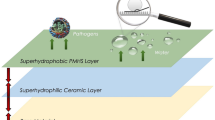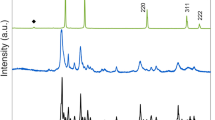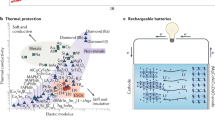Abstract
Hydrophobic materials that are robust to harsh environments are needed in a broad range of applications1,2,3. Although durable materials such as metals and ceramics, which are generally hydrophilic, can be rendered hydrophobic by polymeric modifiers4, these deteriorate in harsh environments. Here we show that a class of ceramics comprising the entire lanthanide oxide series, ranging from ceria to lutecia, is intrinsically hydrophobic. We attribute their hydrophobicity to their unique electronic structure, which inhibits hydrogen bonding with interfacial water molecules. We also show with surface-energy measurements that polar interactions are minimized at these surfaces and with Fourier transform infrared/grazing-angle attenuated total reflection that interfacial water molecules are oriented in the hydrophobic hydration structure. Moreover, we demonstrate that these ceramic materials promote dropwise condensation, repel impinging water droplets, and sustain hydrophobicity even after exposure to harsh environments. Rare-earth oxide ceramics should find widespread applicability as robust hydrophobic surfaces.
This is a preview of subscription content, access via your institution
Access options
Subscribe to this journal
Receive 12 print issues and online access
$259.00 per year
only $21.58 per issue
Buy this article
- Purchase on Springer Link
- Instant access to full article PDF
Prices may be subject to local taxes which are calculated during checkout





Similar content being viewed by others
References
Quéré, D. Non-sticking drops. Rep. Prog. Phys. 68, 2495–2532 (2005).
Bocquet, L. & Lauga, E. A smooth future? Nature Mater. 10, 334–337 (2011).
Quéré, D. Wetting and roughness. Annu. Rev. Mater. Res. 38, 71–99 (2008).
Liu, K. & Jiang, L. Metallic surfaces with special wettability. Nanoscale 3, 825–838 (2011).
Zhang, X., Zhu, Y. & Granick, S. Hydrophobicity at a Janus interface. Science 295, 663–666 (2002).
Chandler, D. Interfaces and the driving force of hydrophobic assembly. Nature 437, 640–647 (2005).
Giovambattista, N., Debenedetti, P. G. & Rossky, P. J. Enhanced surface hydrophobicity by coupling of surface polarity and topography. Proc. Natl Acad. Sci. USA 106, 15181–15185 (2009).
Kuna, J. J. et al. The effect of nanometer-scale structure on interfacial energy. Nature Mater. 8, 837–842 (2009).
Giovambattista, N., Debenedetti, P. G. & Rossky, P. J. Effect of surface polarity on water contact angle and interfacial hydration structure. J. Phys. Chem. B 111, 9581–9587 (2007).
Kung, H. H. Transition Metal Oxides: Surface Chemistry and Catalysis Ch. 4 (Elsevier, 1989).
Drzymala, J. Hydrophobicity and collectorless flotation of inorganic materials. Adv. Colloid Interface Sci. 50, 143–185 (1994).
Hass, K. C., Schneider, W. F., Curioni, A. & Andreoni, W. The chemistry of water on alumina surfaces: reaction dynamics from first principles. Science 282, 265–268 (1998).
Argyris, D., Ashby, P. D. & Striolo, A. Structure and orientation of interfacial water determine atomic force microscopy results: Insights from molecular dynamics simulations. ACS Nano 5, 2215–2223 (2011).
Stirnemann, G., Rossky, P. J., Hynes, J. T. & Laage, D. Water reorientation, hydrogen-bond dynamics and 2D-IR spectroscopy next to an extended hydrophobic surface. Faraday Discuss. 146, 263–281 (2010).
Adachi, G., Imanaka, N. & Kang, Z. C. Binary Rare Earth Oxides Ch. 2 (Kluwer Academic, 2004).
Topp, N. E. The Chemistry of The Rare Earth Elements Ch. 1 (Elsevier, 1965).
Cheng, E., Cole, M. W., Saam, W. F. & Treiner, J. Helium prewetting and nonwetting on weak-binding substrates. Phys. Rev. Lett. 67, 1007–1010 (1991).
Nasher, P. J. & Dupont-Roc, J. Experimental evidence for nonwetting with superfluid helium. Phys. Rev. Lett. 67, 2966–2969 (1991).
Yalamanchili, M. R., Atia, A. A. & Miller, J. D. Analysis of interfacial water at a hydrophilic silicon surface by in-situ FTIR/internal reflection spectroscopy. Langmuir 12, 4176–4184 (1996).
Scatena, L. F., Brown, M. G. & Richmond, G. L. Water at hydrophobic surfaces: Weak hydrogen bonding and strong orientation effects. Science 292, 908–912 (2001).
Du, Q., Freysz, E. & Shen, R. Surface vibrational spectroscopic studies of hydrogen bonding and hydrophobicity. Science 264, 826–828 (1994).
Good, R. J. Contact angle, wetting, and adhesion: A critical review. J. Adhes. Sci. Technol. 6, 1269–1302 (1992).
Martínez, L. et al. Surface study of cerium oxide based coatings obtained by cathodic electrodeposition on zinc. Appl. Surf. Sci. 257, 6202–6207 (2011).
Jiang, K. Fabrication and Catalytic Property of Cerium Oxide Nanomaterials Ch. 2 (Univ. Nebraska, 2011).
Boreyko, J. B. & Chen, C. H. Self-propelled dropwise condensate on superhydrophobic surfaces. Phys. Rev. Lett. 103, 184501 (2009).
Rose, J. W. Dropwise condensation theory and experiment: A review. Proc. Inst. Mech. Eng. A 216, 115–128 (2002).
Neumann, A. W., Abdelmessih, A. H. & Hameed, A. The role of contact angles and contact angle hysteresis in dropwise condensation heat transfer. Int. J. Heat Mass Transfer 21, 947–953 (1978).
Merte, H. & Yamali, C. Profile and departure size of condensation drops on vertical surfaces. Wärme - und Stoffübertragung 17, 171–180 (1983).
Lewis, J. A. Colloidal processing of ceramics. J. Am. Ceram. Soc. 83, 2341–2359 (2000).
Acknowledgements
We are grateful for support from the NSF Career Award (0952564), Dupont-MIT Alliance, MIT Energy Initiative, and DARPA Young Faculty Award. We thank S. Speakman from CMSE at MIT for supporting XRD characterizations and K. Broderick from MTL at MIT for help with sputtering. We thank R. Cohen of MIT for carefully reading and commenting on the manuscript.
Author information
Authors and Affiliations
Contributions
K.K.V. and G.A. conceived the research. K.K.V. supervised the research. G.A. fabricated the sintered pellets and coated substrates, carried out surface wettability and surface-energy characterization, and performed SEM, XPS, XRD and FTIR-GATR characterizations. A.T.P. and G.A. conducted steam condensation experiments. H-M.K. fabricated textured surfaces and prepared the Supplementary Movies. R.D. and G.A. carried out drop impact tests. G.A. carried out the high-temperature stability and abrasive-wear tests and measured the materials’ hardness. All authors contributed to writing and revising the manuscript.
Corresponding author
Ethics declarations
Competing interests
The authors declare no competing financial interests.
Supplementary information
Supplementary Information
Supplementary Information (PDF 1814 kb)
Supplementary Information
Supplementary Movie S1 (MOV 11683 kb)
Supplementary Information
Supplementary Movie S2 (MOV 4529 kb)
Supplementary Information
Supplementary Movie S3 (MOV 4407 kb)
Rights and permissions
About this article
Cite this article
Azimi, G., Dhiman, R., Kwon, HM. et al. Hydrophobicity of rare-earth oxide ceramics. Nature Mater 12, 315–320 (2013). https://doi.org/10.1038/nmat3545
Received:
Accepted:
Published:
Issue Date:
DOI: https://doi.org/10.1038/nmat3545
This article is cited by
-
Shape-controlled RGO/Er2O3-based glass substrates for robust superhydrophobicity
Journal of Nanoparticle Research (2023)
-
Heat Treatment Temperature Effect on Wettability of Laser-Machined Aluminum Surface
Journal of Materials Engineering and Performance (2022)
-
Composite TiO2 films modified by CeO2 and SiO2 for the photocatalytic removal of water pollutants
Photochemical & Photobiological Sciences (2022)
-
Mathematical Analysis of the Structure of Ultrahydrophobic Surfaces Obtained by Atmospheric Plasma Spraying of Zirconium Oxide. 1. Investigation of 2D Profiles
Journal of Engineering Physics and Thermophysics (2022)
-
Functional and versatile superhydrophobic coatings via stoichiometric silanization
Nature Communications (2021)



